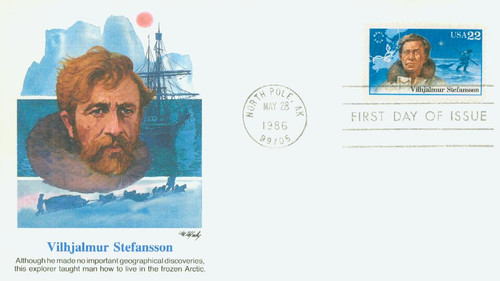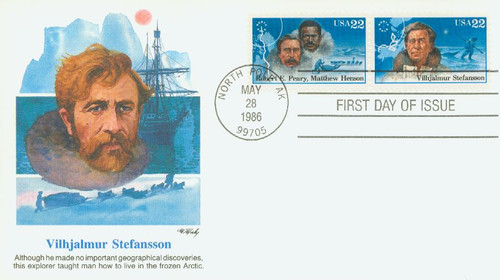
# 2222 - 1986 22c Arctic Explorers: Vilhjalmur Stefansson
U.S. #2222
1986 22¢ Vilhjalmur Stefansson
Polar Explorers
- From block of our stamps honoring explorers of the North Pole
- Includes a portrait, action scene, and route his expedition took
Stamp Category: Commemorative
Set: Polar Explorers
Value: 22¢, first-class rate
First Day of Issue: May 28, 1986
First Day City: North Pole, Alaska
Quantity Issued: 32,500,000
Printed by: American Bank Note Company
Printing Method: Photogravure
Format: Panes of 50 in sheets of 200
Perforations: 11
Why the stamp was issued: Part of a block of four honoring men who played key roles in discovering and unlocking the North Pole.
About the stamp design: Vilhjalmur Stefansson explored the Beaufort Sea – the last great unknown Arctic area. His stamp shows him carrying a harpoon and dragging his seal catch across the ice.
First Day City: The First Day ceremony for this set was held at the North Pole High School auditorium in North Pole Alaska, near Fairbanks.
About Polar Explorers Set: This was the eighth US stamp issue designed by Dennis Lyall. In addition to portraits and smaller scenes of the men honored, each stamp includes a small map showing the route they took on their expeditions. The portraits and scenes were thoroughly researched to ensure accuracy, down to the correct types of ships and sleds.
History the stamp represents:
Vilhjalmur Stefansson was born on November 3, 1879, in Manitoba, Canada. Stefansson’s parents had moved from Iceland to Manitoba two years before he was born. After terrible flooding led to the deaths of two of his siblings, Stefansson’s parents moved the family to North Dakota in 1880.
Stefansson went on to attend the Universities of North Dakota and Iowa before entering graduate studies in anthropology at Harvard. He later taught for two years at Harvard. Stefansson went to Iceland in 1904 to conduct archaeological research. Then in 1906 he joined an Anglo-American Polar Expedition. During that expedition he lived with the Inuit of the Mackenzie Delta. From 1908 to 1912, he participated in a survey of the Central Arctic coasts of North America for the American Museum of Natural History.
In 1913, Stefansson organized and directed the Canadian Arctic Expedition for the Government of Canada. Lasting until 1916, the expedition used three ships to explore areas west of the Parry Archipelago. In August of 1913, one of the ships, the Karluk, became trapped in ice. Stefansson and a small party left the ship to hunt for food as provisions on board were inadequate. While they were gone, the ship drifted with the ice, out of reach of the hunting party. Over the next four and a half months, the ice carried the ship hundreds of miles west before it was crushed and sunk. The remaining 25 people who were on board the vessel were stranded, and eleven died before they were rescued.
In 1921, Stefansson planned an expedition to Wrangel Island, north of Siberia. He had sent four young men there in the hopes colonizing the area. If successful, he believed it could be the base for an exploration company that offered tours to people interested in the Arctic island. However, the four young men were unprepared and ill-equipped for their task and all died there. Before that, they had raised the British flag, as Stefansson had hoped to claim the land for Britain. The island was considered Russian territory however, so this sparked an international incident.
While this incident and the sinking of the Karluk had tainted his reputation, Stefansson is remembered for several discoveries during his travels. He discovered the Brock, Mackenzie King, Borden, Meighen, and Lougheed Islands. He also found the edge of the continental shelf. Stefansson also expanded on the discoveries of Francis Leopold McClintock. In 1920, he reported discovering a lost collection of supplies from the 1853 McClintock expedition of Melville Island. Stefansson was awarded the Royal Geographical Society’s Founder’s Gold medal in 1921 for his life’s work.
Later in life, Stefansson became director of polar studies at Dartmouth College. He also helped establish the US Army’s Cold Regions Research and Engineering Laboratory. During his career, Stefansson served as president of the Explorer’s Club, was a member of the American Polar Society, and served as president of the History of Science Society. Stefansson died on August 26, 1962.
U.S. #2222
1986 22¢ Vilhjalmur Stefansson
Polar Explorers
- From block of our stamps honoring explorers of the North Pole
- Includes a portrait, action scene, and route his expedition took
Stamp Category: Commemorative
Set: Polar Explorers
Value: 22¢, first-class rate
First Day of Issue: May 28, 1986
First Day City: North Pole, Alaska
Quantity Issued: 32,500,000
Printed by: American Bank Note Company
Printing Method: Photogravure
Format: Panes of 50 in sheets of 200
Perforations: 11
Why the stamp was issued: Part of a block of four honoring men who played key roles in discovering and unlocking the North Pole.
About the stamp design: Vilhjalmur Stefansson explored the Beaufort Sea – the last great unknown Arctic area. His stamp shows him carrying a harpoon and dragging his seal catch across the ice.
First Day City: The First Day ceremony for this set was held at the North Pole High School auditorium in North Pole Alaska, near Fairbanks.
About Polar Explorers Set: This was the eighth US stamp issue designed by Dennis Lyall. In addition to portraits and smaller scenes of the men honored, each stamp includes a small map showing the route they took on their expeditions. The portraits and scenes were thoroughly researched to ensure accuracy, down to the correct types of ships and sleds.
History the stamp represents:
Vilhjalmur Stefansson was born on November 3, 1879, in Manitoba, Canada. Stefansson’s parents had moved from Iceland to Manitoba two years before he was born. After terrible flooding led to the deaths of two of his siblings, Stefansson’s parents moved the family to North Dakota in 1880.
Stefansson went on to attend the Universities of North Dakota and Iowa before entering graduate studies in anthropology at Harvard. He later taught for two years at Harvard. Stefansson went to Iceland in 1904 to conduct archaeological research. Then in 1906 he joined an Anglo-American Polar Expedition. During that expedition he lived with the Inuit of the Mackenzie Delta. From 1908 to 1912, he participated in a survey of the Central Arctic coasts of North America for the American Museum of Natural History.
In 1913, Stefansson organized and directed the Canadian Arctic Expedition for the Government of Canada. Lasting until 1916, the expedition used three ships to explore areas west of the Parry Archipelago. In August of 1913, one of the ships, the Karluk, became trapped in ice. Stefansson and a small party left the ship to hunt for food as provisions on board were inadequate. While they were gone, the ship drifted with the ice, out of reach of the hunting party. Over the next four and a half months, the ice carried the ship hundreds of miles west before it was crushed and sunk. The remaining 25 people who were on board the vessel were stranded, and eleven died before they were rescued.
In 1921, Stefansson planned an expedition to Wrangel Island, north of Siberia. He had sent four young men there in the hopes colonizing the area. If successful, he believed it could be the base for an exploration company that offered tours to people interested in the Arctic island. However, the four young men were unprepared and ill-equipped for their task and all died there. Before that, they had raised the British flag, as Stefansson had hoped to claim the land for Britain. The island was considered Russian territory however, so this sparked an international incident.
While this incident and the sinking of the Karluk had tainted his reputation, Stefansson is remembered for several discoveries during his travels. He discovered the Brock, Mackenzie King, Borden, Meighen, and Lougheed Islands. He also found the edge of the continental shelf. Stefansson also expanded on the discoveries of Francis Leopold McClintock. In 1920, he reported discovering a lost collection of supplies from the 1853 McClintock expedition of Melville Island. Stefansson was awarded the Royal Geographical Society’s Founder’s Gold medal in 1921 for his life’s work.
Later in life, Stefansson became director of polar studies at Dartmouth College. He also helped establish the US Army’s Cold Regions Research and Engineering Laboratory. During his career, Stefansson served as president of the Explorer’s Club, was a member of the American Polar Society, and served as president of the History of Science Society. Stefansson died on August 26, 1962.











